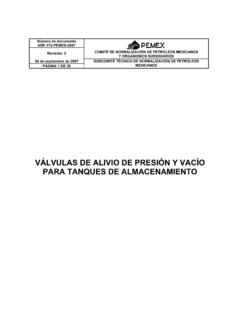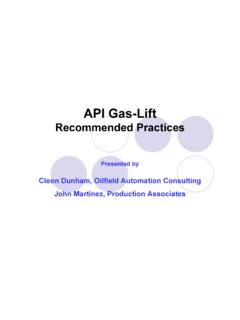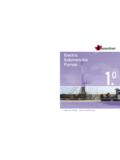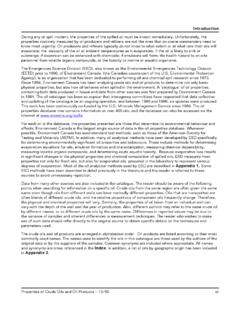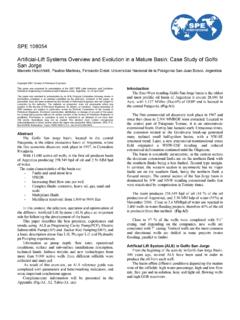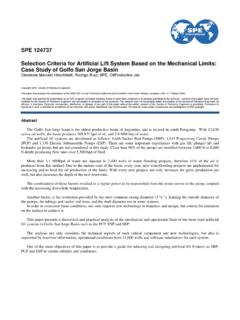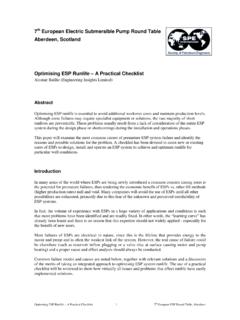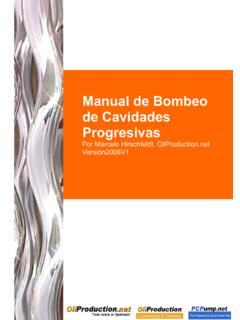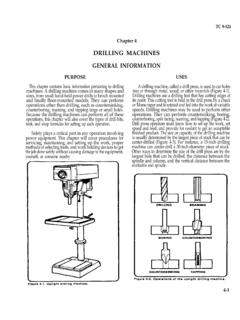Transcription of Department of Petroleum Engineering PETE 203: DRILLING ...
1 KING FAHD UNIVERSITY OF Petroleum & MINERALS Department of Petroleum Engineering pete 203: DRILLING Engineering LABORATORY MANUAL APRIL 2003 ii PREFACE The purpose of this manual is two fold: first to acquaint the DRILLING Engineering students with the basic techniques of formulating, testing and analyzing the properties of DRILLING fluid and oil well cement, and second, to familiarize him with practical DRILLING and well control operations by means of a simulator.
2 To achieve this objective, the manual is divided into two parts. The first part consists of seven experiments for measuring the physical properties of DRILLING fluid such as mud weight (density), rheology (viscosity, gel strength, yield point) sand content, wall building and filtration characteristics. There are also experiment for studying the effects of, and treatment techniques for, common contaminants on DRILLING fluid characteristics. Additionally, there are experiments for studying physical properties of Portland cement such as free water separation, normal and minimum water content and thickening time.
3 In the second part, there are five laboratory sessions that involve simulated DRILLING and well control exercises. They involve the use of the DS-100 Derrick Floor Simulator, a full replica of an actual DRILLING rig with fully operations controls, which allow the student to become completely absorbed in the exercises as he would in an actual DRILLING operation. The simulator has realistic DRILLING rig responses that are synchronized to specific events, like rate of penetration, rotary table motion, and actual rig sounds such as accumulator recharge, break drawworks, etc.
4 It is hoped that the material in this manual will effectively supplement the theory aspect presented in the main course. iii TABLE OF CONTENTS PART I: DRILLING FLUID AND CEMENTING 1. 2. Table of 3. Laboratory Safety v 4. Experiment No. 1: Mud Weight, Marsh Funnel Viscosity and 5. Experiment No. 2: Mud Rheology 6. Experiment No. 3: Filtration, Wall Building and 7. Experiment No. 4. Mud Weight 8. Experiment No. 5. DRILLING Fluid Contamination 9. Experiment No.
5 6. Solid, Liquid Content and Emulsion Characteristic of DRILLING 10. Experiment No. 7. Oil Well Cementing PART II: DRILLING SIMULATOR SESSIONS 11. Front Page for DRILLING Simulator Laboratory 12. Lab. Session 1: Familiarization and Line-up of Operational Components 13. Lab. Session 2: Familiarization and Line-up of Operational Components 14.
6 Lab. Session 3: Operation of Major 15. Lab. Session 4: Kick Identifications and Well Shut-in iv 16. Lab. Session 5: Kick Control Exercises: Well Control 17. Appendix A: 18. Appendix B: Format for Laboratory 19. Appendix C: Classification, Composition and Preparation of DRILLING 20. Appendix D: Miscellaneous 20. Appendix E: DRILLING Fluid and Cementing Expt. Equipment ..92 v LABORATORY SAFETY INSTRUCTIONS Safety in the laboratory must be of vital concern to all those engaged in experimental science work.
7 It is therefore the responsibility of everyone to adhere strictly to the basic safety precautions provided and to avoid any acts of carelessness that can endanger his life and that of others around him. It is equally important to always abide by all the instructions for conducting the experimental work during the laboratory sessions. Below are some guidelines for general laboratory safety and procedures: 1. All students must be familiar with the locations and operational procedures of the Emergency Shower, Fire Extinguishers, Gas Masks and Fire Blankets.
8 These safety devices pictured below. 2. Laboratory coats, safety glasses and safety shoes MUST be worn at all times during the laboratory session. NO THOABS and open sandals are allowed during the laboratory sessions. 3. Eating, drinking and smoking are strictly PROHIBITED in the laboratory at all times. Laboratory glassware should NEVER be used for drinking purpose. 4. Report any injury immediately for First Aid treatment, no matter how small. 5. Report any damage to equipment or instrument and broken glassware to the laboratory instructor as soon as such damage occurs.
9 Emergency Shower Fire Blankets Gas Mask and Fire Extinguisher 1 EXPERIMENT NO. 1 MUD WEIGHT, MARSH FUNNEL VISCOSITY AND pH (A) MUD WEIGHT OR DENSITY TEST: Theory The density of the DRILLING fluid must be controlled to provide adequate hydrostatic head to prevent influx of formation fluids, but not so high as to cause loss of circulation or adversely affect the DRILLING rate and damaging the formation.
10 Normal pressure gradient by water is equal to ( psi/ft) and equal to 433 psi/1000 ft. Test Equipment The Baroid Mud Balance as shown below is used to determine density of the DRILLING fluid. The instrument consists of a constant volume cup with a lever arm and rider calibrated to read directly the density of the fluid in ppg (water ), pcf (water ), specific gravity (water = ) and pressure gradient in psi/1000 ft. (water 433 psi/1000 ft.) Figure : Typical Mud Balance 2 Calibration 1. Remove the lid from the cup, and completely fill the cup with water.
